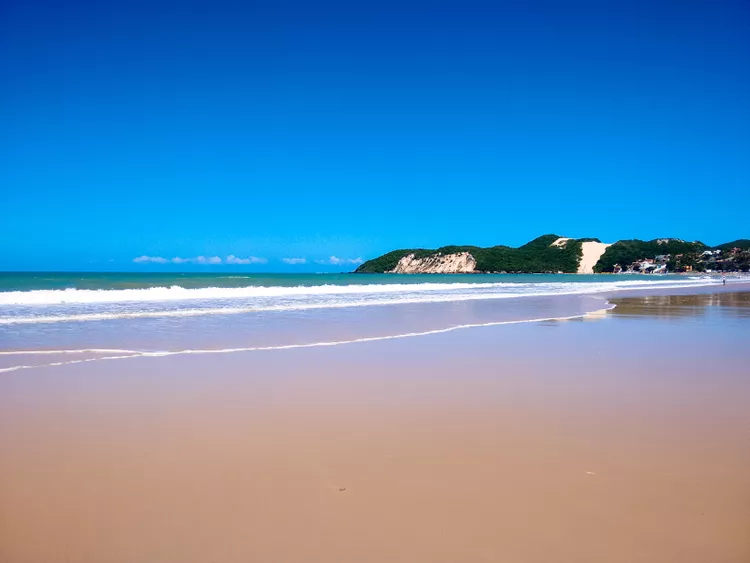Natal Beaches: A Hidden Gem on the Brazil Coast
Natal beaches offer travelers the wild and rustic beauty that define the Rio Grande do Norte coastline. The area, which is said to have 300 sunny days a year, also boasts great sand dunes, cliffs, reefs which form ocean pools, and lots of wind.
Kitesurfing is one of the popular sports on Natal beaches. You don’t have to try it to feel the power of the windiest days on the sands of Natal. Take a family member’s extra-large T-shirt and hold it by the hem above your head to create your own oversized windsock – it’s pretty impressive.
Natal beaches usually do well in beach quality reports. The most recent updates are made available by Programa Água Viva.
Natal’s Northern Coast
Access to Natal’s northern coast was greatly improved with the opening of Ponte de Todos – Newton Navarro over the Potengi River. The bridge, also known as Ponte Forte-Redinha, links Natal’s Fortaleza dos Reis Magos to the beach.
Redinha is a laid back beach where the thing to do is sit at one of the beach kiosks (now almost under the bridge) and eat ginga com tapioca. To most travelers, it’s a fun, can’t-miss stop on the way to Genipabu, one of the top attractions along the Brazil coast.
It takes at least a full day to enjoy the Genipabu sand dunes and lagoon. Buggy rides and sand surfing are the top activities. However, while there are hundreds of buggy drivers in Natal, not all of them are qualified professionals, and most only speak Portuguese.
The Southern Coast
Going south, a string of beaches with diverse fun options extends all the way to Tibau do Sul and Pipa.
Praia do Forte, located next to the Fort, features calm waters, making it perfect for relaxation. Furthermore, Praia do Meio and Praia dos Artistas offer kiosks and are known for good surfing conditions. Areia Preta (Black Sand) is lined with residential apartment buildings and has dark sands, accompanied by ocean pools during low tide.
Via Costeira, or the Coastal Way, runs parallel with Barreira d’Água, a continuation of Areia Preta, and hosts one of the largest concentrations of hotels in Natal.
Ponta Negra is divided into two areas – a busier section with numerous kiosks and restaurants, and a quieter area where most of its many hotels are situated. If you venture uphill to Alto de Ponta Negra, you’ll find yourself in the heart of Natal’s vibrant nightlife.
RN-063, also known as Rota do Sol (the Sun Route), starts in Ponta Negra and meanders along the southern coast. Praia do Cotovelo, located just south, offers warm, calm waters and many summer homes belonging to Natal locals.
Near Cotovelo, you’ll pass the exit to the town of Parnamirim (pop. 172,751) and the Barreira do Inferno Rocket Launch Base.
Pirangi do Norte is not only great for kitesurfing but is also famous for being home to the world’s largest cashew tree, which is easily accessible from the beach. Kids will enjoy climbing the tree’s gnarled branches.
While Cotovelo and Pirangi do Norte are typically part of the Natal southern coast, they are actually within Parnamirim, whose main core is located inland.
Pirangi do Sul features a quaint fishermen’s village. Its calm waters lead to ocean pools during low tides, making it another great spot for kitesurfing.
Located in Nísia Floresta (pop. 22,906), Búzios is one of the largest beaches on the southern Natal coast. The northern end of the beach, encircled by reefs, provides excellent snorkeling opportunities, while the southern end is favored for its outstanding surfing conditions.
Additionally, the cliffs bordering the next beach, Tabatinga do Sul, create one of the best vantage points on the northeastern coast to watch the sunset and the dolphins that frolic in the lower tide. This can be experienced at Mirante dos Golfinhos, or the Dolphin Lookout Point, a well-known local restaurant.
Camurupim, with its stunning reefs, tranquil waters, and sandy dunes, is conveniently located near one of the area’s many lagoons: Arituba.
Barreta, the final beach on Natal’s southern coast, marks the end of the asphalt road, leading to the Guaraíras lagoon. Here, buggies are required to cross the lagoon’s mouth to reach Tibau do Sul and its most famous beach: Praia da Pipa.





